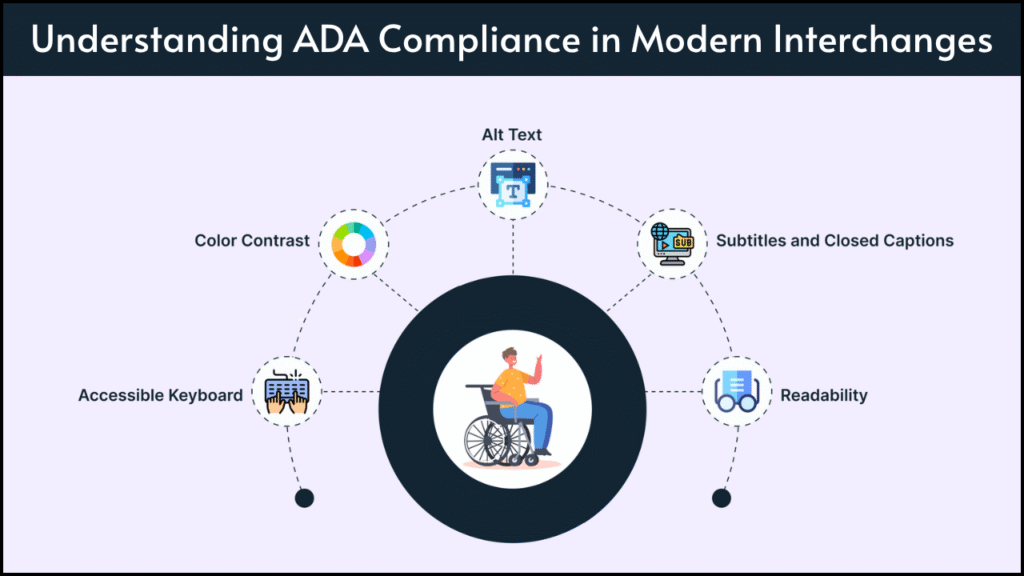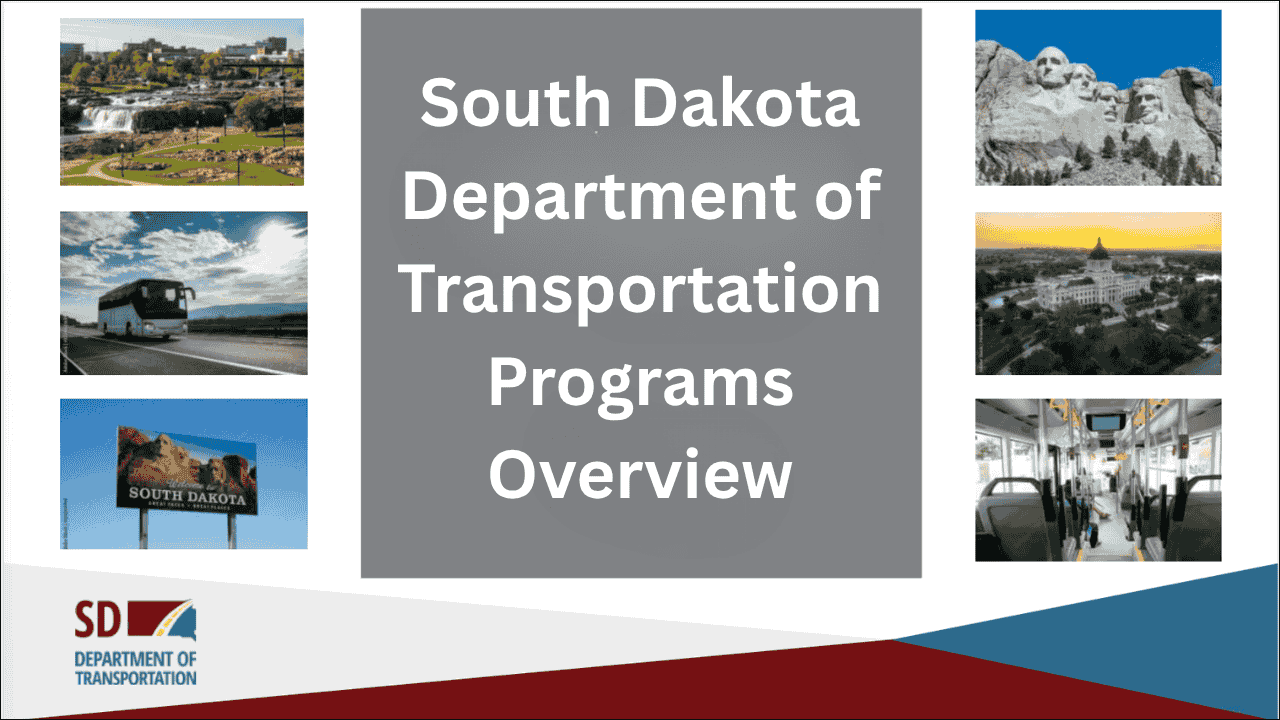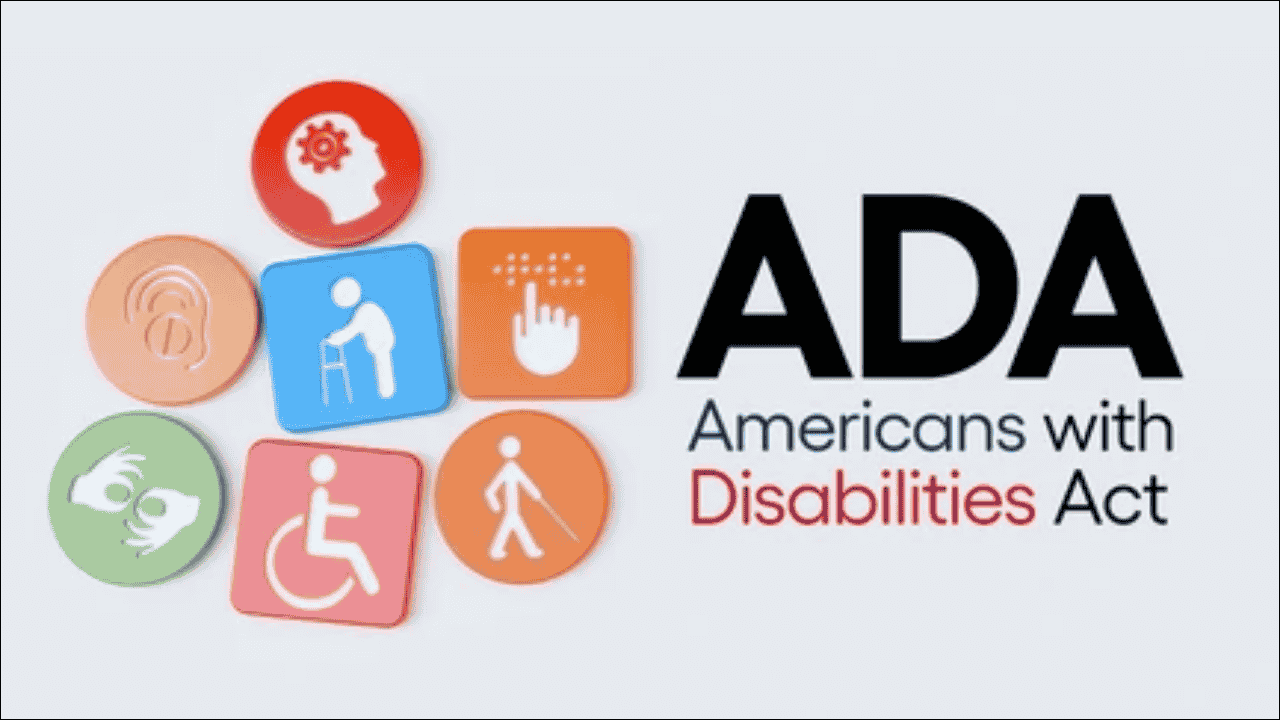
Accessibility plays a key role in transportation infrastructure. The Americans with Disabilities Act (ADA) ensures that roads, signals, and pedestrian facilities are usable by all people, including those with disabilities. Modern interchanges are now designed with careful attention to ADA standards. Pedestrian ramps, signals, and crossings must meet strict requirements to ensure safety, usability, and equal access.
Table of Contents
ADA Standards in Interchange Design
Design guidelines from the ADA include the following rules:
- Ramps must have gentle slopes, handrails (if steep), and tactile warnings.
- Signals must include audible features and pushbuttons within reach.
- Crosswalks must be marked clearly and be accessible from curb ramps.
Pedestrian Ramps in Interchanges
Ramps allow wheelchair users and others with mobility challenges to move between road levels.
- Slope Requirements: A maximum slope of 1:12 is allowed. This means 1 inch of rise for every 12 inches of run.
- Width: Minimum width should be 36 inches to allow wheelchair movement.
- Surface Texture: Surface must be firm, stable, and slip-resistant.
- Edge Protection: Ramps must have edge protection to prevent wheels from slipping off.
- Landing Areas: Flat areas at the top and bottom help users pause or turn easily.
Curb Ramp Types and Their Features
| Ramp Type | Location | Features |
|---|---|---|
| Perpendicular Ramp | Cuts directly into the curb | Straight ramp, often with flared sides |
| Parallel Ramp | Runs alongside the curb | Two ramps with a flat landing between |
| Combination Ramp | Mix of both types | Often used at complex corners or wide crossings |
Detectable Warning Surfaces
Detectable warnings help visually impaired individuals recognize the edge of the sidewalk.
- Texture: Small raised domes indicate a crossing or drop-off.
- Color: Usually yellow or contrasting with the pavement for visibility.
- Placement: Installed at the bottom of ramps before entering the street.
Accessible Pedestrian Signals (APS)
Signals play an important role in safe crossing for people with vision or hearing impairments.
- Audible Messages: Tones or verbal messages let users know when to cross.
- Vibrotactile Features: Some pushbuttons vibrate to signal walk intervals.
- Location and Reach: Buttons must be within 42 inches of the ground and located near the ramp.
- Clear Instructions: Some signals include Braille or raised characters for instructions.
Key Signal Components in ADA Compliance
| Component | Requirement |
|---|---|
| Pushbutton height | 42 inches maximum from ground level |
| Reach range | Must be easily reachable from a wheelchair |
| Button diameter | Minimum 2 inches |
| Feedback | Must give a light, tone, or vibration when pressed |
| Location | Close to crossing and no more than 10 inches from the ramp |
Crosswalk Accessibility in Interchanges
Safe crossings are essential for ADA compliance in busy interchanges.
- Markings: Crosswalks must have clear, white striping, often with zebra-style lines.
- Width: Minimum width should be 6 feet, wider in busy areas.
- Median Islands: If crossings are long, rest areas (islands) are added in the center.
- Timing: Signal timing must be long enough for slower pedestrians to cross safely.
- Grade and Slope: Crosswalks should be as level as possible, with a cross slope not greater than 2%.
Challenges in ADA Implementation at Interchanges
Modern interchanges often include overpasses, ramps, and complex paths.
- Large Elevation Changes: Designers must find ways to include ramps without creating steep paths.
- Traffic Volume: High traffic means signals and crossings must be well-planned for safety.
- Space Constraints: Urban areas may lack space for ideal ramp slopes or landing areas.
- Retrofit Projects: Older interchanges need upgrades, which are often costly and complex.
Best Practices in ADA-Compliant Interchanges
| Practice | Benefit |
|---|---|
| Including users in the design process | Designs are more practical and effective |
| Conducting accessibility audits | Identifies problems early |
| Installing APS at all crossings | Improves safety for visually impaired users |
| Using contrasting ramp materials | Helps users detect changes in walking surfaces |
| Keeping curb ramps aligned | Guides users directly to crosswalks |
Innovations in Accessibility Design
Modern technology and creative planning are improving interchange access.
- Smart Signals: Some cities are using sensors to extend crossing times when needed.
- Modular Ramp Systems: Prebuilt ramps are being used in temporary or changing areas.
- Wayfinding Systems: GPS-guided or tactile pathways are emerging for low-vision navigation.
- Green Infrastructure Integration: Accessible routes now blend with landscaping and stormwater systems.
Common Mistakes to Avoid
| Mistake | Why It’s a Problem |
|---|---|
| Placing ramps far from crosswalks | Confuses users and creates safety risks |
| Ignoring tactile surface requirements | Leaves visually impaired pedestrians at risk |
| Inaccessible signal pushbuttons | Prevents safe and legal crossing |
| Steep ramp slopes | Difficult or unsafe for wheelchair users |
| Narrow ramp widths | Hard for larger mobility devices to pass |
Benefits of ADA Compliance in Interchanges
- Safety for Everyone: Features help children, elderly people, and others, not just those with disabilities.
- Legal Compliance: Following the ADA helps avoid lawsuits and penalties.
- Public Image: Communities gain a reputation for inclusivity and responsibility.
- Future-Proofing: Designing accessible infrastructure now saves money on future upgrades.
End Notes
Modern interchanges are no longer built only for cars—they are for everyone. ADA compliance ensures that ramps, signals, and crossings are accessible, safe, and convenient. Proper planning, execution, and innovation help cities meet the legal and ethical responsibility to serve all members of society. Prioritizing accessibility results in better infrastructure for all users.





